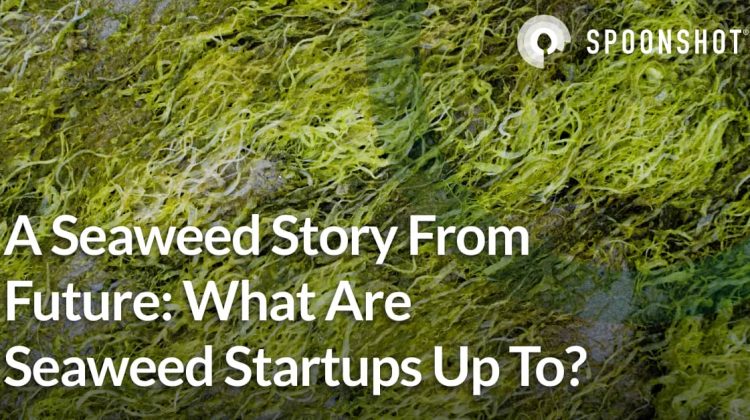
I love seaweed. I also live in a part of the world where seaweed is not easily available or particularly affordable when it is available, and that makes me sad. However, I’m going to wager that this situation is going to start changing pretty darn quick-ish, given the growing attention being bestowed on these marine marvels and some very innovative seaweed startups that are changing how we used seaweed as a food ingredient.
In just the first six months of this year, interest in algae like seaweed and kelp inched up after a significant decline over 2020 – references to seaweed, kelp, and algae in consumer and business media fell by nearly 35% over the course of the year after a fairly steady run in the previous years. Since early 2021, interest in seaweed (and its various cohorts) has gone up by 20% and is projected to go up by another 15% over the next 12 months, based on Spoonshot’s analysis.
Interest in seaweed, kelp, and algae has started to increase after a significant decline in 2020

The plants fantastic: a seaweed story
This interest in seaweed comes on the heels of the pandemic, with consumers looking for more foods and ingredients with functional benefits for overall better health.
- In fact, demand for seaweed in the US has grown so much that Maine is expecting to have the largest ever seaweed harvest in the state, at around 800,000 pounds of kelp. This is around six times the harvest from two years ago.
- It isn’t just the US that’s seeing a bumper harvest. Several other parts of the world are also cashing in on the growing demand for seaweed, including Australia, Indonesia, South Korea, and Tunisia.
There is also a lot of funding going into the sector.
- Just this month, the Australian government said that it had awarded AUD59 million in grants to 68 organizations working on new health products made from seaweed.
- Also in July 2021, an Indian startup called Sea6 Energy, a vertically integrated seaweed producer, processor, and developer, won US$9 million in funding too.
A growing body of research that is finding new potential health benefits for these plants as food as well as various uses besides those of the edible persuasion. Much like mushrooms (check out our recent blog on the expanding functional benefits of mushroom), we expect seaweed and its ilk to become a lot more popular as a functional ingredient beyond just sushi.
There are numerous varieties of seaweed but the three main categories are brown algae (like kombu), green algae (like sea lettuce), and red algae (like nori). There are also numerous varieties of edible seaweed, like dulse that tastes like bacon when fried. The different seaweeds have different nutritional and functional benefits as well.
Recipe-based novelty and consumer liking score (out of 10) for select types of seaweed

Nutritional and functional benefits of seaweed
Gut health benefits
A study published in Marine Drugs in June 2021 details how exactly red seaweeds are able to offer health benefits. The basis for this research was the fact that several previous studies had found that Asians who ate seaweed regularly were at lower risk of developing colon, colorectal, and breast cancer. Japan, for example, has the lowest number of colon cancer patients. However, the specific compound responsible for these anti-cancer properties was not known.
In this study, researchers tested various sugars produced when different types of red seaweed were broken down to pin down the ones that offered the health benefits. Six sugars were produced, of which two showed significant promise – agarotriose and 3,6-anhydro-L-galactose (AHG).
- Agarotriose was found to work as a prebiotic and enhanced probiotic activity.
- AHG was found to inhibit the growth of human colon cancer cells without impacting the growth of normal cells since it is able to trigger apoptosis or cell death.
Weight management benefits
Another study published in the Journal of Nutritional Biochemistry (also in June 2021) has pointed to the potential benefits of sugar kelp grown in Connecticut in preventing weight gain and the onset of conditions associated with obesity. This is the first study to look at the link between US-grown sugar kelp and obesity.
Brown sugar kelp was found to impede hepatic inflammation and fibrosis in mice with induced non-alcoholic steatohepatitis, a fatty liver disease associated with obesity. It can cause inflammation of the liver as well as reduced functionality. Mice on a high-fat diet that included sugar kelp had lower body weight and less adipose tissue versus mice on a high-fat diet sans sugar kelp. The sugar kelp was found to help in preventing the accumulation of fat in the liver.
The mice on the sugar kelp diet were also noted to have healthier gut microbiomes.
Also Read: Guide to Lab Grown Food
Nutritional powerhouse
Since different seaweed varieties have different nutritional profiles, generic proclamations about nutrition are not very useful. However, in general, these are low-cal and, in many cases, low in sodium despite their saltiness. Dried kelp can also be used instead of salt and is very useful for people looking to cut down on their table salt consumption.
Many varieties are rich in protein and amino acids as well as in fiber. There is also research to indicate that alginate, a compound found in seaweed, may aid appetite control. Several types of seaweed also contain various vitamins and minerals – maybe even more than our everyday vegetables.
The flip side
It is important to point out that some types of seaweed can be tainted with heavy metals in contaminated water. Some nutrients in seaweed (like iodine) can also be potentially harmful to some people. So consumption should be in moderation.
Must Read: Food Trends Prediction for 2022
All prepped for expansion
Seaweed is not a mainstream ingredient in many parts of the world. Within product launches across the US, UK, and Australia, only 0.2% had seaweed as an ingredient. And the bulk of these products were snacks in the form of seaweed sheets or chips, positioned as better-for-you snacks compared to standard chips.
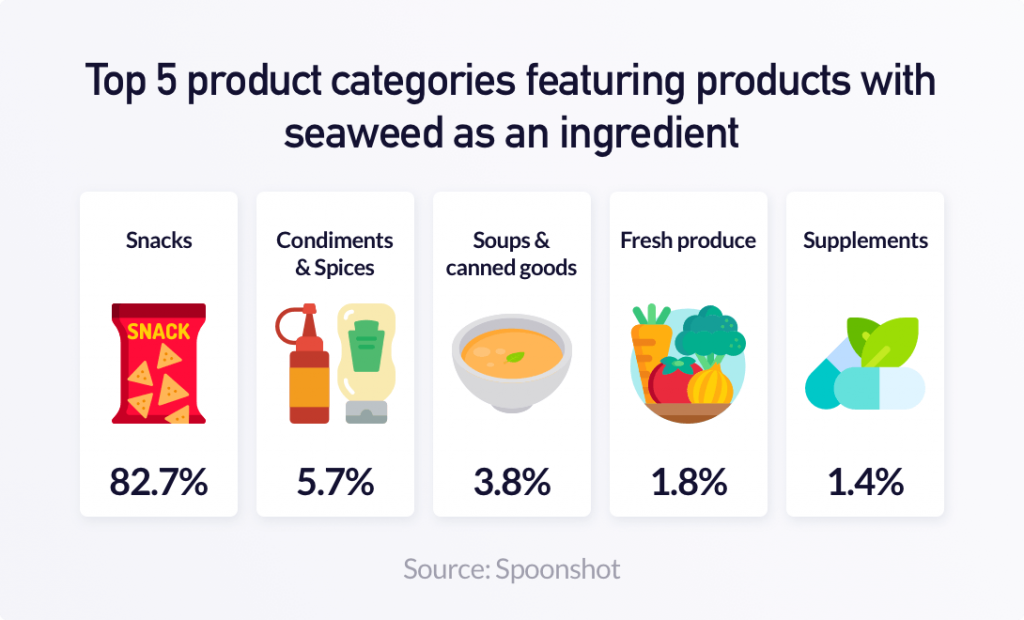
Top innovative seaweed startups to watch out for
- Misaky Tokyo is a Japanese company that makes handcrafted candy from seaweed that they call crystal treats. The products come in a range of flavors, including butterfly pea, lavender, matcha, and yuzu, and have a unique texture – crunchy on the outside and gummy-like inside. The company calls out the high fiber content of seaweed as well as its digestive health and cholesterol lowering properties. These are vegan and gluten-free.
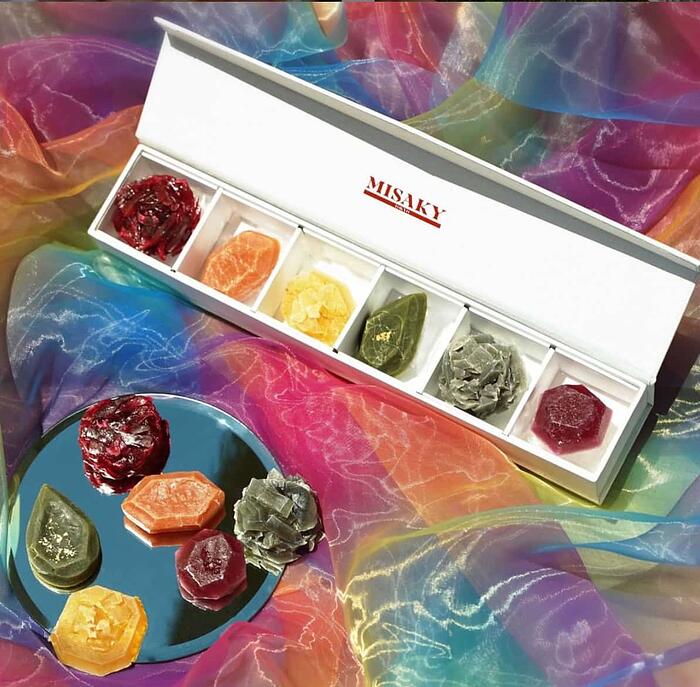
- Akua, which makes a range of kelp jerky snacks, expanded its portfolio in May 2021 with what is being touted as the world’s first kelp burger. The burger is made with ocean-farmed kelp, crimini mushrooms, pea protein, black beans, quinoa, and crushed tomatoes. Ocean-farmed kelp is a highly sustainable crop that does not require fresh water, fertilizers, or arid land to grow. In addition, they also absorb carbon and nitrogen from the water, helping to replenish the oceans.
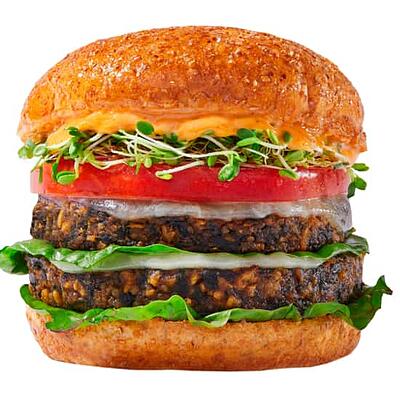
- Viridi Laboratorium has created what it says is the world’s first fucus jelly ready for consumption. Fucus is a type of perennial brown algae found on shorelines in many parts of the world. According to the company, their proprietary technology allows them to open the cell membrane of the algae and convert the initial compounds of the cells cytoplasm into a colloidal form without heat or chemicals. This is said to make the seaweed easier to digest and increase the bioavailability of the nutrients.

Norwegian startup Sjy Seaweed and food research institute Nofima are working on a project to create a range of snacks made from Norwegian kelp. Their initial product is a porous and extruded crisp-like product with a cheese puff-like texture that contains 7.5% kelp.
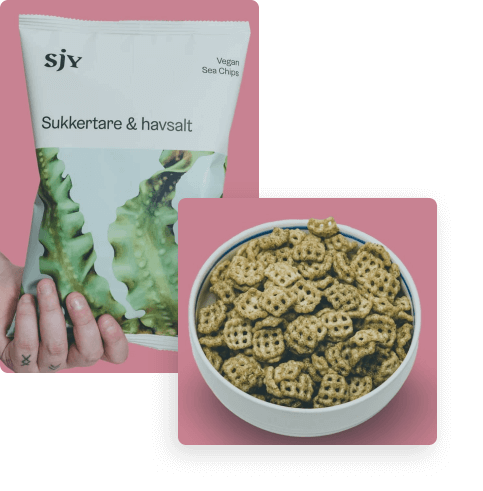
With seaweed becoming more popular for its various functional benefits, we’re going to see the ingredient find its way into a range of new product categories with varied functionalities. This should further fuel the demand for various types of seaweed and algae. Seaweed has immense potential in carbon capture to tackle climate change, making it an ingredient worth looking into in terms of its environmental sustainability as well.
So with all these positive points, even if the seaweed is always greener in somebody else’s lake, that’s perfectly fine by me!



Leave a Reply